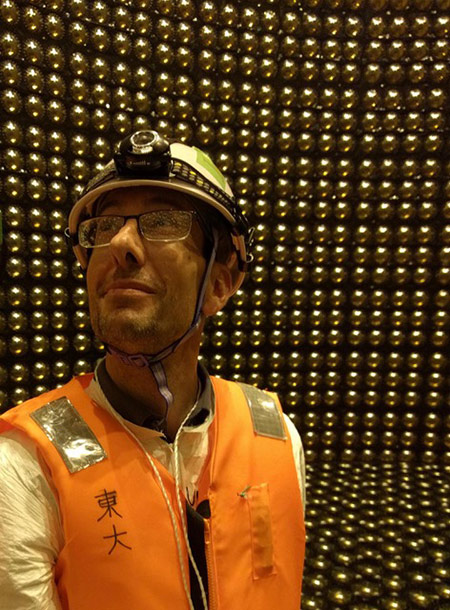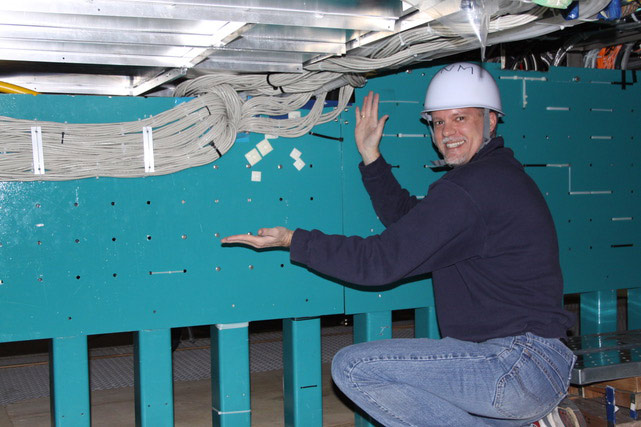A team of international scientists, including researchers from the University of Rochester Department of Physics and Astronomy, has made a major step forward in solving a mystery that has perplexed particle physicists for decades: Why is the universe made up almost exclusively of matter, when matter and antimatter were created in equal amounts during the Big Bang?
Matter and antimatter particles annihilate one another if they come into contact. Somehow, the matter that makes up the universe today-everything from stars and planets to people and everyday objects-escaped this annihilation. Physicists reason that something must have broken this matter-antimatter symmetry.

Rochester physics professor Kevin McFarland in a tank at the T2K experiment test facility in Japan during reconstruction work in August 2018. (University of Rochester photo)
In a paper published in the journal Nature, Rochester physics professors Kevin McFarland and Steve Manly and physics postdoctoral research associate Clarence Wret, along with their colleagues in the Japan-based T2K collaboration, reported the strongest measurements yet on asymmetry between subatomic particles called neutrinos and their antimatter counterpart, antineutrinos. Their research suggests that neutrinos may hold the key to the disruption of the matter-antimatter symmetry in the early universe.
"Neutrinos are one of the few places we know in nature where this difference between matter and antimatter could be observed," says McFarland, the Dr. Steven Chu Professor in Physics. "They may be the key to explain why matter and antimatter somehow had different fates as the universe cooled from the Big Bang."
Physics loves symmetry
Almost every particle in the universe, including neutrinos, has an antimatter counterpart; a particle with the same mass, yet an opposite charge.
For most phenomena, the laws of physics dictate a symmetry in the behavior of matter and antimatter. For the universe to evolve to a state where matter dominates over antimatter, there must be a violation of this symmetry.
Until now, symmetry violations between matter and antimatter have only been observed in quarks, but the magnitude of this symmetry violation is not large enough to explain why matter dominated over antimatter in the universe.
Experiments conducted in a mine in Japan may hold new clues to this disparity.
What are neutrinos?
There are two categories of subatomic particles that comprise the matter in our universe: quarks and leptons. Quarks make up the protons and neutrons inside atoms and come in six different types, or "flavors." Leptons, too, come in different flavors, including electrons and neutrinos.
Neutrinos are notoriously difficult to study because they carry no electrical charge and have nearly no mass. They are sometimes referred to as "ghost particles" because, compared to other known subatomic particles, neutrinos rarely interact with atoms.
Neutrinos themselves also come in three distinct flavors: electron neutrinos, muon neutrinos, and tau neutrinos. The flavors are determined by whether or not the neutrino produces an electron or one of the heavier copies of electrons in nature, a muon or tau.
The T2K collaboration
In the T2K experiment in Japan, a proton accelerator located in the village of Tokai on the east coast of Japan created an intense beam of muon neutrinos and their antimatter counterpart, muon antineutrinos. The neutrinos were directed to the Super-Kamiokande detector in the Kamioka mine beneath Mt. Ikeno, 295 km away, near the west coast of Japan.
As the muon neutrinos and muon antineutrinos traveled the distance from Tokai to Kamioka (hence the name T2K), they oscillated-or changed flavor-from muon neutrinos and muon antineutrinos into electron neutrinos or electron antineutrinos, respectively.
When the T2K group studied and measured the neutrino and antineutrino oscillations, they found minute differences in their behavior, indicating a violation of symmetry between matter and antimatter.
"We don't know of a lot of sources of matter-antimatter asymmetries in nature that could have led to today's universe being so different in matter and antimatter content, and this-neutrinos-is a new such source," McFarland says.
The T2K Collaboration includes more than 500 members from 64 institutions in 12 countries. Rochester has been involved in the T2K group since 2001. Rochester contributions include building significant parts of one of the detectors and developing several key techniques for the experiment, including a new detection method that found one-sixth of the oscillated electron neutrinos. Wret and McFarland are additionally involved in many of the day-to-day details of the analysis.
These findings are Rochester's most recent contribution to a long history of neutrino research. McFarland, Manly, two Rochester postdocs, and a former graduate student were part of a team that was awarded the 2016 Breakthrough Prize in Fundamental Physics "for the fundamental discovery of neutrino oscillations, revealing a new frontier beyond, and possibly far beyond, the standard model of particle physics." Along with Arie Bodek, the George E. Pake Professor of Physics at Rochester, McFarland and Manly were members of a collaboration named in Physics World magazine's list of top 10 breakthroughs for 2012 for being the first to demonstrate communications using neutrinos. The current research additionally builds on experiments conducted by Rochester alumnus Masatoshi Koshiba '55 (PhD), who was one of three physicists awarded the 2002 Nobel Prize in Physics for his work to detect neutrinos.

Rochester physics professor Steve Manly shows off post-cable-tie cleanup at the T2K facility in Japan. Several Rochester researchers are members of the T2K collaboration, which recently reported strong evidence that neutrinos may hold the key to the disruption of the matter-antimatter symmetry in the early universe. (University of Rochester photo)






